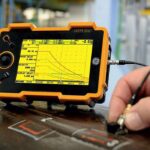Acoustic emission is a very versatile, non-invasive way to gather information about a material or structure. Acoustic Emission testing (AET) is be applied to inspect and monitor pipelines, pressure vessels, storage tanks, bridges, aircraft, and bucket trucks, and a variety of composite and ceramic components. It is also used in process control applications such as monitoring welding processes. A few examples of AET applications follow.
Weld Monitoring

During the welding process, temperature changes induce stresses between the weld and the base metal. These stresses are often relieved by heat treating the weld. However, in some cases tempering the weld is not possible and minor cracking occurs. Amazingly, cracking can continue for up to 10 days after the weld has been completed. Using stainless steel welds with known inclusions and accelerometers for detection purposes and background noise monitoring, it was found by W. D. Jolly (1969) that low level signals and more sizeable bursts were related to the growth of microfissures and larger cracks respectively. ASTM E 749-96 is a standard practice of AE monitoring of continuous welding.
Bucket Truck (Cherry Pickers) Integrity Evaluation

Accidents, overloads and fatigue can all occur when operating bucket trucks or other aerial equipment. If a mechanical or structural defect is ignored, serious injury or fatality can result. In 1976, the Georgia Power Company pioneered the aerial manlift device inspection. Testing by independent labs and electrical utilities followed. Although originally intended to examine only the boom sections, the method is now used for inspecting the pedestal, pins, and various other components. Normally, the AE tests are second in a chain of inspections which start with visual checks. If necessary, follow-up tests take the form of magnetic particle, dye penetrant, or ultrasonic inspections. Experienced personnel can perform five to ten tests per day, saving valuable time and money along the way. ASTM F914 governs the procedures for examining insulated aerial personnel devices.
Gas Trailer Tubes

Acoustic emission testing on pressurized jumbo tube trailers was authorized by the Department of Transportation in 1983. Instead of using hydrostatic retesting, where tubes must be removed from service and disassembled, AET allows for in situ testing. A 10% over-pressurization is performed at a normal filling station with AE sensors attached to the tubes at each end. A multichannel acoustic system is used to detection and mapped source locations. Suspect locations are further evaluated using ultrasonic inspection, and when defects are confirmed the tube is removed from use. AET can detect subcritical flaws whereas hydrostatic testing cannot detect cracks until they cause rupture of the tube. Because of the high stresses in the circumferential direction of the tubes, tests are geared toward finding longitudinal fatigue cracks.
Bridges

Bridges contain many welds, joints and connections, and a combination of load and environmental factors heavily influence damage mechanisms such as fatigue cracking and metal thinning due to corrosion. Bridges receive a visual inspection about every two years and when damage is detected, the bridge is either shut down, its weight capacity is lowered, or it is singled out for more frequent monitoring. Acoustic Emission is increasingly being used for bridge monitoring applications because it can continuously gather data and detect changes that may be due to damage without requiring lane closures or bridge shutdown. In fact, traffic flow is commonly used to load or stress the bridge for the AE testing.
Aerospace Structures

Most aerospace structures consist of complex assemblies of components that have been design to carry significant loads while being as light as possible. This combination of requirements leads to many parts that can tolerate only a minor amount of damage before failing. This fact makes detection of damage extremely important but components are often packed tightly together making access for inspections difficult. AET has found applications in monitoring the health of aerospace structures because sensors can be attached in easily accessed areas that are remotely located from damage prone sites. AET has been used in laboratory structural tests, as well as in flight test applications. NASA’s Wing Leading Edge Impact Detection System is partially based on AE technology. The image to the right shows a technician applying AE transducers on the inside of the Space Shuttle Discovery wing structure. The impact detection system was developed to alert NASA officials to events such as the sprayed-on-foam insulation impact that damaged the Space Shuttle Columbia’s wing leading edge during launch and lead to its breakup on reentry to the Earth’s atmosphere.
Others
● Fiber-reinforced polymer-matrix composites, in particular glass-fiber reinforced parts or structures (e.g. fan blades)
● Material research (e.g. investigation of material properties, breakdown mechanisms, and damage behavior)
● Inspection and quality assurance, (e.g. wood drying processes, scratch tests)
● Real-time leakage test and location within various components (small valves, steam lines, tank bottoms)
● Detection and location of high-voltage partial discharges in transformers
● Railroad tank car and rocket motor testing
There are a number of standards and guidelines that describe AE testing and application procedures as supplied by the American Society for Testing and Materials (ASTM). Examples are ASTM E 1932 for the AE examination of small parts and ASTM E1419-00 for the method of examining seamless, gas-filled, pressure vessels.


